Remember The Sectional I wrote about last month? We’ve decided to return it!
Cozey has a very generous 30-day return policy:
Choosing the right sofa can be tricky, which is why we offer a 30-day risk-free trial. We want you to be confident in your decision, so use these 30 days to sit and nap on it, binge watch all your favourites, or read into the morning. If for whatever reason, the product doesn’t fit your needs, we will take it back for free. Simply keep all the boxes it shipped in.
That’s exactly what we did: we lived with the sectional for close to a month, and decided that, in the end, it wasn’t for us. For a bunch of reasons, but mostly because it ended up being far to precious for our lifestyle: the fabric colour and style meant that it went from being elegant and beautiful to looking schlumpy and in need of a cleaning after just a little bit of use. Future projections were not good. We need something that will wear better and stand up to the exigencies of our life.
I emailed Cozey on Sunday to request a return and received pre-paid Purolator shipping labels two hours later. It took the better part of a day to disassemble and re-box everything (thank goodness we kept all the boxes and packing materials!) and it will get picked up this afternoon.
The search continues…
Learned helplessness is an interesting idea, and Wikipedia sums up current thinking well:
Learned helplessness is the behavior exhibited by a subject after enduring repeated aversive stimuli beyond their control. It was initially thought to be caused by the subject’s acceptance of their powerlessness: discontinuing attempts to escape or avoid the aversive stimulus, even when such alternatives are unambiguously presented. Upon exhibiting such behaviour, the subject was said to have acquired learned helplessness. Over the past few decades, neuroscience has provided insight into learned helplessness and shown that the original theory had it backward: the brain’s default state is to assume that control is not present, and the presence of “helpfulness” is what is learned first. However, it is unlearned when a subject is faced with prolonged aversive stimulation.
In other words: we learn that we’ve got control, and when things go sideways, over and over again, we unlearn it.
I’ve been thinking about this a lot because I’ve been finding myself perplexingly incapable of late. I’m a smart guy with enormous privilege, financial resources, and I’ve been known to have moxie by times. And yet problems that, in theory, are solvable have been slaying me, and I’ve been grasping for reasons why.
Driving downtown this morning after dropping off Olivia, I was thinking about how this might relate to Catherine’s death and the grief surrounding it.
From her incurable cancer diagnosis in 2014 until her death in 2020 Catherine accepted her fate: she did not rail against the darkness, and accepted that she was going to die. I followed her into that, and while I generally regarded it as the right attitude, the only reasonable attitude, I’m wondering now whether that also constituted “enduring repeated aversive stimuli beyond my control.”
What is the long-term effect on the psyche from waking up every morning to be reminded of the everpresence of impending doom?
I notice my disability most when it comes to confronting gnarly problems with many interlinked aspects (aspects that often lead down blind alleys or into brick walls). These are the types of problems that I’ve always excelled at, earned my living from, and I’ve loved solving them. But not so much of late.
What describes the process of caring for someone living with incurable cancer better than “confronting gnarly problems with many interlinked aspects.”
I’ve lost my taste for the challenge; I’m exhausted by the gnarly.
I want things to be simple.
And yet they are not.
And so I need a new plan, one that lets me rebuild my sense of helpfulness. I need a way to route around the brick walls. To not get flummoxed and debilitated by a feeling of how-can-this-possibly-be-so-hard. To break down things into bite-sized chunks. To make maps of things that, at one time, I might have been able to hold in my head. To ask for help, over and over and over again. To release my attachment to completeness, perfection.
My brain has been changed by what I’ve been through, in ways I’m only just beginning to understand; it’s time that I accept that, and work to adapt.
I’m upping my game from Canadian Tire fire logs to maple firewood harvested from Hurricane Fiona-downed trees from the back yard.
I met Stefan Kirkpatrick on the day he was born, in Peterborough, Ontario, in 1988.
His parents, George and Leslie, were good friends of mine; confidants, protectors.
Two years later I travelled with Leslie and Stefan to El Paso, Texas for two months, caring for Stefan as Leslie studied midwifery. In retrospect I’ve no idea how I thought myself capable of such a task, but it worked: Stefan remained alive and, on occasion, enriched. We had good times together, exploring the city, going to $1 movies, eating tacos, and listening, incessantly, to a cassette tape of The Three Pigs. We made a crazy voyage, by air, from El Paso to Canada and back. I fed him, entertained him (and he me), was driven crazy by him at times and delighted by him at others. It was my first experience having a little one under my wings; I’m not sure I could have gone on to become a parent myself without Stefan teaching me how.
Eventually George arrived, I returned to Canada, first to Montreal and then back to Peterborough. George, Leslie, and Stefan returned the next spring, and I was there when Stefan turned four years old, an epic birthday party where Catherine, in an act of great charity, dressed as Big Bird so as to fulfil my outlandish promise to Stefan than Big Bird would be there for his birthday.
The next spring Catherine and I moved to Prince Edward Island, and I lost touch with Stefan.
For a long, long time.
He got older, moved to Port Hope, went to school, grew up, travelled, moved to Nova Scotia, fell in love, got married, had a child, opened a business, bought a house, had another child.
I saw him briefly, 15 years ago, passing through town, before a lot of that happened, but not since.
Until today.
We trekked from our temporary base north of Halifax out to West Dublin, in driving rain, to drop in for an overdue visit.
It was a delight, all over again.
Stefan remains the lively spirit I knew at two years old: creative, funny, warm, smart. The spark I saw every day, long ago, remains in his eye.
He took us on a tour of his chocolate factory, introduced us to his wife Desiree and their kids. He fed us tasty pastries and hot tea. Leslie arrived, as a surprise. We talked of the old days, told stories, some of which I alone remembered, some of which only they.
Stefan Kirkpatrick turned 34 years old this week: I played a large role in a small slice of his life; he played an outsized role in mine. That he’s grown into a father, partner, entrepreneur, traveller, is heartbreakingly satisfying to witness.
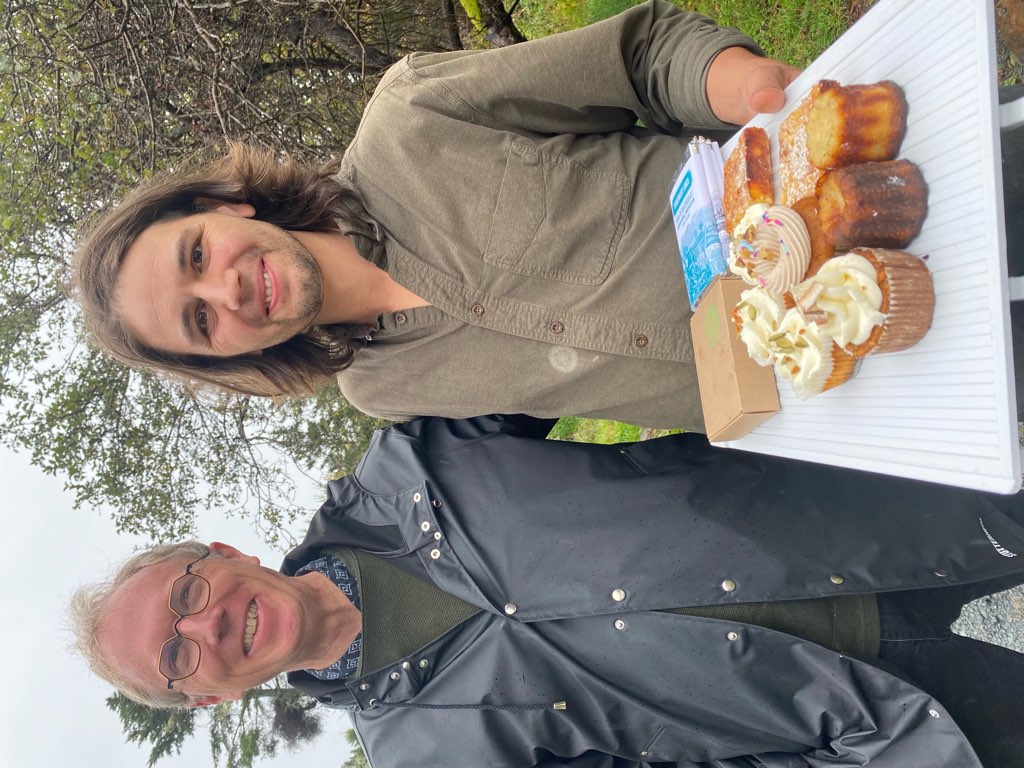
Through the Red Cross, the Province of PEI is sending $250 to each Prince Edward Island household that registers here.
“Everyone has been impacted in some way by Hurricane Fiona,” said Premier Dennis King. “From spoiled food, to property damage, to extra costs incurred from fuel and emergency supports. Government is working hard to make the restoration of our Island and homes a little easier on everyone.”
While the need to register is clearly a barrier for those without electricity or Internet, the implementation of this program is quick and efficient: I received an e-transfer yesterday, less than 48 hours after I registered.
My Kia Soul EV was charging in my driveway this weekend, a little closer to the sidewalk than usual because we had two cars in the driveway.
When I came out in the morning to unplug the charger, half the connector stayed in the car, the victim, it seems, of someone walking by in the night who decided to haul on it (when the car is locked the charge connector is locked in place).
A pain at the best of times, additionally so as the insurance and electrician professions are over-taxed this week due the hurricane.
We celebrated Olivia last night with a small gathering of Charlottetown friends in The Rafters on Queen Street, a last minute post-hurricane celebration that will be followed up later with a larger do.
My neighbours Doug, Andrea, and Meghan, Lisa, my brother Mike and his partner Karen, and my friend Lauranne, have been very helpful in clearing the felled trees from the back yard here at 100 Prince Street.
This was the scene when I opened the back door on Saturday afternoon, an impenetrable wall of trees:
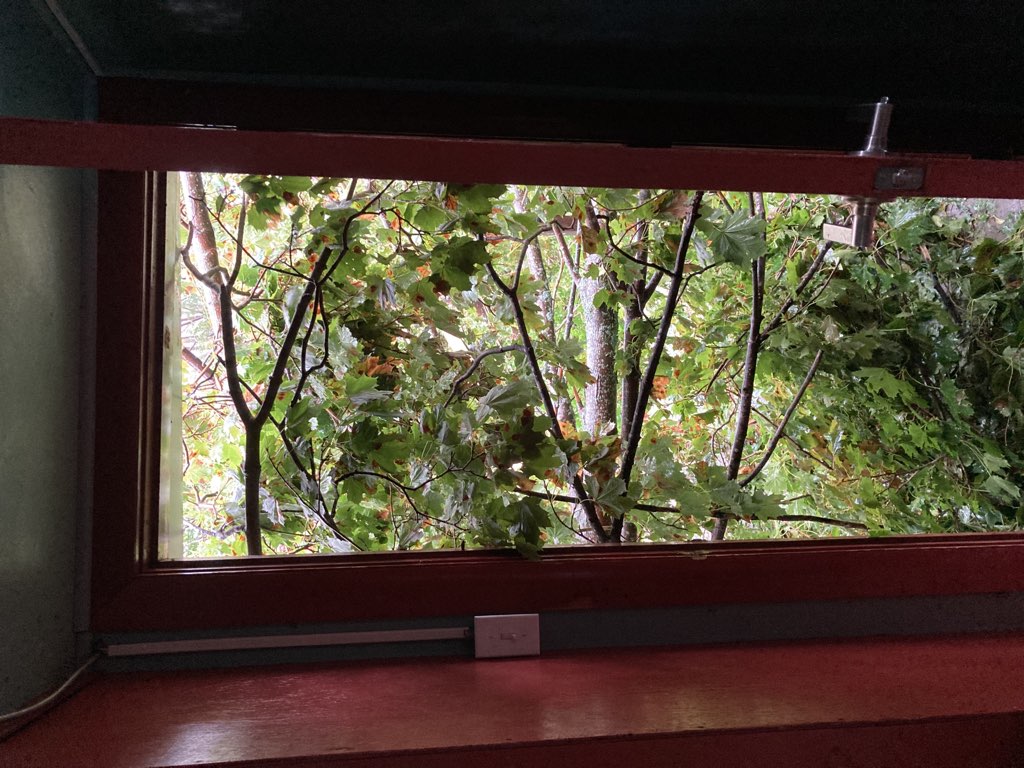
Less than 24 hours later, on Sunday afternoon, thanks to Doug’s help, and the very powerful handsaw that I inherited from my father, the debris was almost completely removed from the back deck (and my biceps considerably weakened):

By Monday we’d hauled all the debris from the deck and from the front part of the yard out to the curb, and the prospect of clearing out everything began to seem less infinite:

On Tuesday, Doug used his electric chainsaw to start attacking the larger issues: he trimmed the tree on the left, about halfway back, and we hauled much of it to the curb:

By yesterday evening—Wednesday—the entire middle tree, and the large tree at the back of the yard were cleared, and a lot of the debris under the apple trees on the right was cleared out too (all three apple trees survived; the plum tree got toppled. but is unbroken and might be saved):
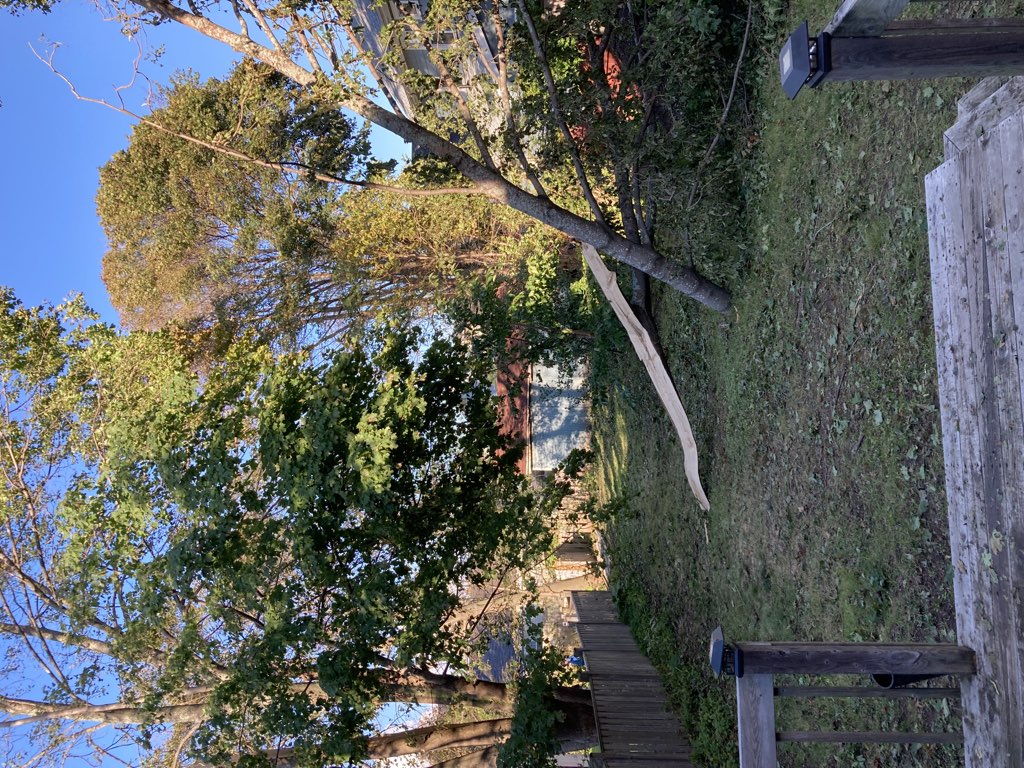
The tree that remains in the photo above is the scariest one of all, both in where it came from and in removing it: it flew about 3 metres from the fence line, from high atop the tree you can still see standing on the left.
As you can see in the photo below, it has wedged itself into an embrace with a much larger tree, still standing and apparently solid, across the fence on the right. The damage that tree could have done to our house, our neighbours’ houses, or even just the fences, would have been considerable had things gone differently. We’re going to leave that tree to the professionals, as cutting it down ourselves isn’t safe.
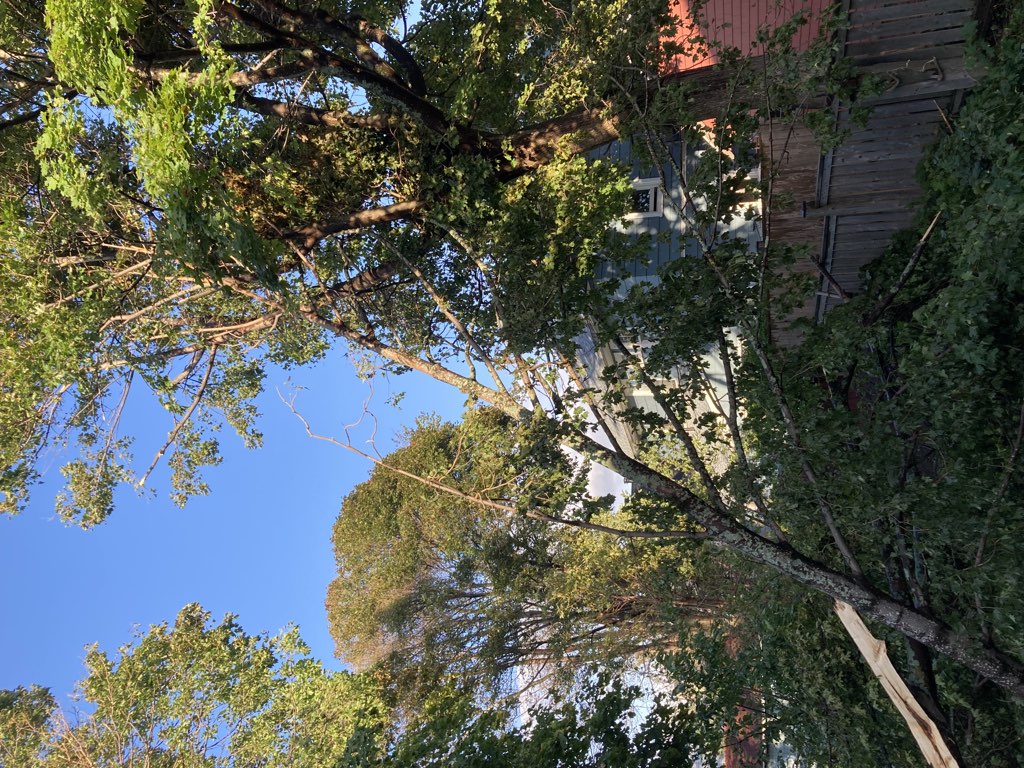
Tuesday afternoon a crew from Island Coastal came along the street with a steam shovel (yes, I am a child of the 1960s) with a big claw on the front, and a frontend loader, and deftly ate up everything we had placed on the curb. I expect they’ll be making another round later in the week.
Last night, walking home from across the street at the office, I took this shot of our blessed house:
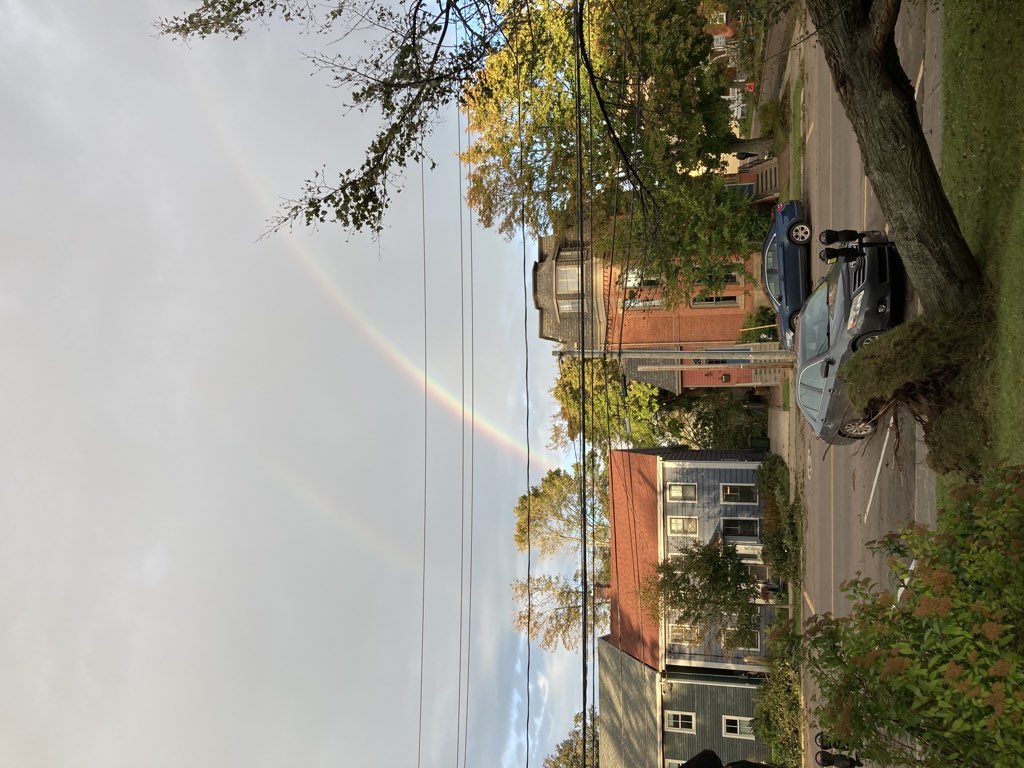
Meanwhile, across the street at the aforementioned office, things are in disarray: when the power came back on, the circulating pumps for the district heating system appear to have caused a pressure surge, which broke an old cast iron pipe to the radiator in my office, which caused a small flood. Nothing was damaged but the floor, but the office nor the print shop are usable until the rad is repaired and the floor cleaned and repainted. Fiona’s tentacles are deep.
We’ve just come out the other end of Hurricane Fiona. The worst of the storm passed through Prince Edward Island in the early morning hours of Saturday, September 24.
Inspired by a blog post from Matt Webb about monitoring CO2, in mid-summer I purchased an Aranet4 CO2 monitor and placed it on my desk in my basement office at St. Paul’s Church Parish Hall: I wanted to get a sense of the CO2 in the not-very-well-ventilated workspace.
I dropped in at the office this morning and downloaded the data for the past week into my phone. The device measures not only CO2, but also humidity, temperature, and pressure.
As expected, the lowest pressure of the last week was 5:39 a.m. on Saturday, at 960 hPa:
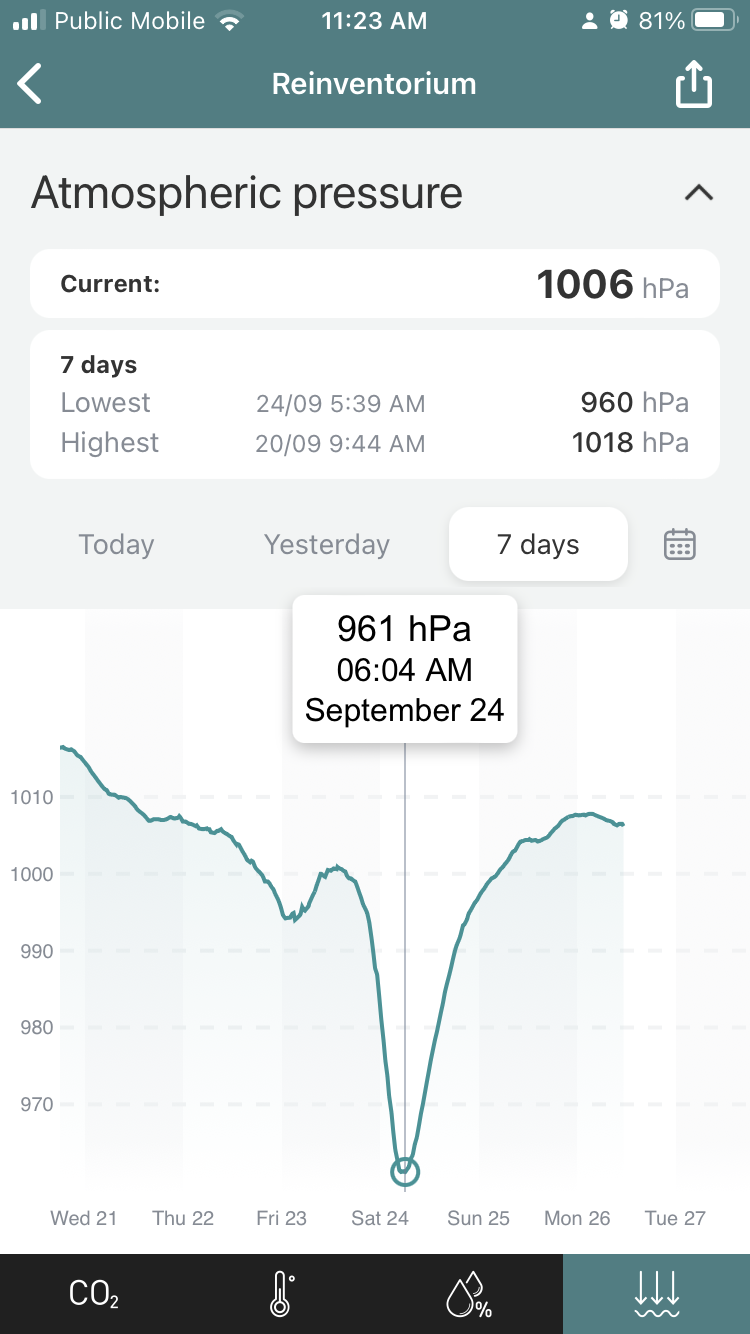
What I find interesting, is that this was coincident with the highest recorded CO2 on my station, 2432 ppm:

I don’t have the meteorological nor physics understanding to know how these two readings are related; I welcome any thoughts from those who know more than I.
 I am
I am